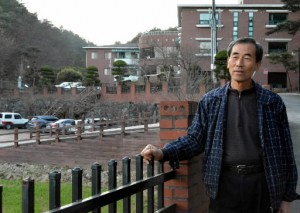Hiroshima of South Korea, 70 Years After the Atomic Bombing: Part 3
Jan. 8, 2016
Part 3: Can joint efforts between Japan and South Korea advance nuclear abolition?
by Kyosuke Mizukawa, Staff Writer
At the construction site of a new atomic bomb museum in Hapcheon County, located in South Gyeonsang Province, South Korea, Sim Jintae, 72, stressed that the nuclear weapon states lack an understanding of the inhumane nature of nuclear arms. Mr. Sim, the manager of the Hapcheon Branch of the South Korean Atomic Bomb Sufferers Association, experienced the atomic bombing of Hiroshima.
Voices of A-bomb survivors and nuclear victims
At an official event of the Review Conference of the Nuclear Non-proliferation Treaty (NPT), held this past May at United Nations headquarters in New York, Mr. Sim spoke as a representative of Korean A-bomb survivors about his experience of the atomic bombing and the negative effects of radiation on human health. After he returned to South Korea and heard the news that the Review Conference had collapsed without an agreement, he trembled with anger at the nuclear powers for using security issues as an excuse for clinging to their nuclear weapons.
Six months later, at the invitation of a citizens’ group, Mr. Sim took part in the World Nuclear Victims’ Forum, a gathering held in Naka Ward, Hiroshima in November. Sharing his impressions of the event, he said that the anti-nuclear appeals made by the nuclear victims of U.S. nuclear test sites, uranium mines in India, and the Fukushima No. 1 (Daiichi) nuclear power plant had been very moving. When Mr. Sim himself took the stage, he insisted that the world will not be a peaceful place as long as nuclear weapons exist. The forum made him keenly aware of the importance of A-bomb survivors and nuclear victims working together closely to abolish nuclear weapons.
Hapcheon County joined Mayors for Peace, headed by Hiroshima Mayor Kazumi Matsui, in 2011. The county will begin constructing the atomic bomb museum next year under the supervision of Ha Chang-hwan, the mayor of Hapcheon County and a second-generation A-bomb survivor. Mr. Matsui is ready to lend support to the county’s goal by providing the museum with materials for display and he hopes the museum will convey a message that can help create a more peaceful future.
While cooperation between South Korea and Japan is anticipated, there are still issues to address. Twenty-nine A-bomb survivors of the Hapcheon Branch have been unable to obtain the Atomic Bomb Survivor’s Certificate because they cannot find a witness to their experience of the atomic bombing. This means that these 29 people will be left outside the scope of the Atomic Bomb Survivors Relief Law and will not be able to receive full reimbursement of their medical expenses after these reimbursements begin next year. The City of Hiroshima, which is investigating certificate applications, should respect the personal statements made by the applicants and respond to the matter in a responsible fashion.
Bowing to the United States
Meanwhile, in terms of relations between South Korea and Japan, the movement calling for an apology and seeking redress from the Japanese government has grown among Korean A-bomb survivors. In 2011, South Korea’s Constitutional Court ruled it unconstitutional that the South Korean government had not confirmed the existence of the right of Korean A-bomb survivors to claim compensation for damage wrought by the atomic bombings, because it was questionable whether the 1965 Korea-Japan Claims Settlement Agreement had nullified that right. The A-bomb survivors then filed a lawsuit against the South Korean government, arguing the government should engage in talks with Japan to negotiate the matter.
Compared to the issue of comfort women for the Japanese military, the South Korean government is reluctant to address the compensation claim. A-bomb survivors living in South Korea suspect this is because the South Korean government would like to avoid pursuing U.S. responsibility for dropping the atomic bombs on Japan. Kim Dosig, 80, a resident of the Hapcheon A-bomb Sufferers Welfare Center, said that Japan and South Korea both bow to the United States, which shelters these two nations beneath its nuclear umbrella. He stressed that South Korea and Japan should first resolve issues involving the past, then push forward, together, to denuclearize the Asian region.
At the entrance to the welfare center is an oak tree that bears a sign with these words: “Symbol of our hope.” An A-bomb survivor who went to Hiroshima for medical treatment, with the support of a citizens’ group, picked up an acorn in the Hiroshima Peace Memorial Park and planted it here. Mr. Sim has been pondering the idea of getting both the public and private sectors to build a “peace park” together with the citizens of Hiroshima, after the atomic bomb museum is completed. His hope is that the “Hiroshima of South Korea” will be a place where both Japanese and South Korean people will commemorate the A-bomb victims and pray for peace. With the construction of this park as a start, he wishes to see cooperation between the two nations grow stronger.
(Originally published on December 18, 2015)








